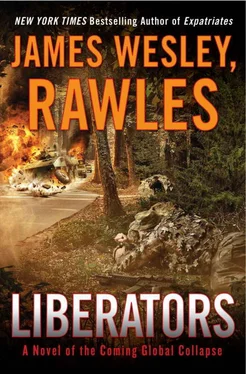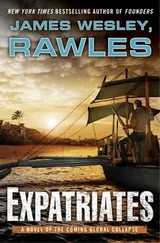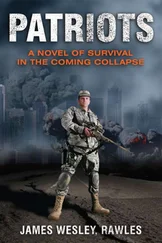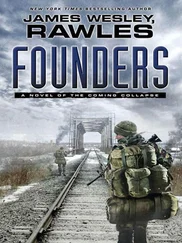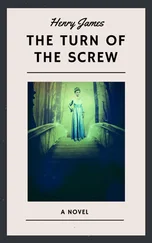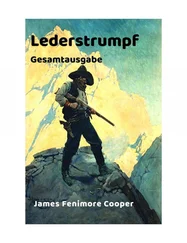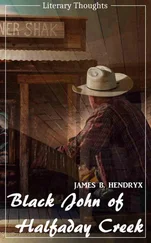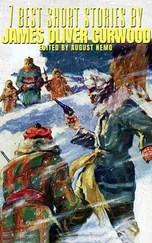They loaded into the Jeep one last time. Joshua was solemn but knew that this was the right thing to do for the greater good. At the pawnshop, Megan went in to see if there was anything else that she wanted to buy with their credit. Joshua’s only warning was, “No cast iron unless you plan on carrying it.” Megan emerged with the two game carts, two spare tires and tubes for each cart, a small tube air pump, the blankets and mess kits, an e-tool, a thousand waterproof strike-on-anything matches, a twelve-by-twenty-four-foot tarp, a five-hundred-foot piece of paracord neatly wound up in a skein, a can of mink oil for their leather personnel carriers (LPCs), some extra bungee cords, a hatchet, a quality Henckels stainless steel kitchen knife, and two Olympia State Forest maps. She took the rest of the difference in pre-1965 “junk” silver U.S. dimes and quarters.
Out of the corner of her eye Megan peeked down the hall and saw a clothes dryer. She noticed that the kid was willing to deal, perhaps because she was an attractive woman or simply because he was very happy about his new Jeep.
“You know, you’re getting a wicked good deal on that Jeep.”
The kid smiled and started to blush, so she asked, “Say, would you trade my sister’s toolbox full of tools here for that Gerber multitool, the flint-and-steel set, and that skinning knife with the gut hook?”
After eyeballing the high quality of the tools inside, he said, “Sure, that’d be fine, ma’am.” The kid behind the counter completed the trade as the old man took a turn on guard duty by the front door.
“Kind of a strange request here, but would you let me empty the lint tray on your dryer? You know, so that I can have some tinder for my flint and steel.” The kid shrugged, and Megan placed the keys to the Jeep on the counter and gave him the title, which Joshua had signed over. The old man countersigned it, and Megan came back from the dryer with the lint to shake hands.
When Megan had walked into the pawnshop, Joshua had remained outside and taken one one-tenth-ounce gold coin from his belt and put it in his pocket. He left Malorie to strip the Jeep of their stuff while he took Jean and Leo to the picked-over chain grocery store a few doors down.
It took half an hour to pack the carts. The girls would take turns pushing the smaller “doe” cart, while Joshua volunteered to push his “buck” cart the entire way. Since it was so cold, the cooked meat that Joshua had packed at the homestead was still deep chilled and fresh. Long weapons went on top, and everyone carried his bug-out bags on his back. The boys had small book-bag-type sacks to carry some water, socks, and a few small toys. Megan asked Joshua to pray for the next part of their journey. After the prayer, they set out on their LPCs over the Big Sandy River Bridge into Kentucky.
On October 15, 1934, with Pan at the wheel… we rattled across the Canadian border.
From government officials, we ascertained that Tatla Lake, five hundred miles north of Vancouver, was the northwestern frontier of existing ranches. West of it lay the little-known Anahim country, walled in on the north by the wild, unexplored Itcha and Algak ranges. Beyond the mountain barrier lay our objective, the mysterious Indian taboo land on the unmapped headwaters of the Blackwater River.
—Richmond P. Hobson, in
Grass Beyond the Mountains: Discovering the Last Great Cattle Frontier on the North American Continent
The McGregor Ranch, near Anahim Lake, British Columbia—October, the First Year
As Claire McGregor was washing the dinner dishes, the Dakota Alert driveway alarm announced, “Alert, zone one, alert, zone one.” She shouted to Alan excitedly, “Mercy! That could be Ray!”
They stepped out on the porch, hoping to see the familiar profile of Ray’s pickup and fifth-wheel trailer, but instead saw the shape of an unfamiliar pickup truck with a camper shell. As the pickup neared the front porch, a motion-sensing security floodlight snapped on.
Claire asked, “Who… ?”
Alan hesitated with his hand resting on the porch rail, wondering whether he should step back inside for his elk rifle.
The unknown man waved, swung open his door, and declared, “Hi! I’m Phil Adams. I trust that Ray let you know that I’d be coming.”
Alan nodded. “Yes, he told us. Come in, come in. Claire can warm you up some dinner.”
As he climbed out of the pickup’s cab Phil asked, “Is Ray here yet?”
Simultaneously, Alan and Claire replied, “No.”
Arriving at the ranch in advance of Ray was awkward. Even though he had known Ray for more than a decade, Phil had never met Ray’s parents face-to-face. And despite the barrage of dramatic news headlines, the whole concept of Phil’s being there to help secure the ranch seemed odd—almost as if it was still in the realm of the hypothetical. It was, after all, a very remote ranch, and the nearest reports of civil unrest were in downtown Vancouver, British Columbia. That was 350 miles away, straight-line distance, or roughly 420 miles by sea and road, or 535 miles via the highways. Further complicating the situation, the telephone network was working only sporadically, and the McGregors hadn’t heard from Ray in three days. Their daughters—one living in Florida and the other living in the Philippines—were also out of contact.
• • •
Outside of a narrow littoral that benefits from the moderating influence of the Pacific Ocean’s thermal mass, northern British Columbia has a brutal climate. Upon leaving Bella Coola and driving east on Highway 20, the interior climate of British Columbia comes suddenly. The Chilcotin mountain range looms up, and without realizing it, you are entering a radically different climate zone. Nighttime temperatures during winter can reach a low of negative twenty-seven degrees Celsius. And daytime highs average right around freezing in January. The cool summers and cold winters in this region, classified as the “Montane Spruce Zone,” result largely from its position in the rain shadow of the Coast Mountains and the high elevations. The low precipitation, dry air, and clear skies at night often create very frigid overnight temperatures.
The McGregor ranch was at a northern latitude where there were sixteen and a half hours of daylight at the summer solstice but only seven and a half hours at the winter solstice. The ranch was fairly close to the tiny hamlet of Anahim Lake, but the nearest good shopping and the nearest freight terminal were eighty-seven miles away in Bella Coola. To anyone outside the region, they used the shorthand of saying that their ranch was “near Bella Coola” because it took too long to explain that they were in the middle of nowhere. The ranch had 720 deeded acres with 410 acres of that in hay ground. (More than half of that had been muskeg swamp when the property was first staked in the 1930s, and then it had to be laboriously drained and cleared, originally with ditches dug by hand.) The property was off the grid, with a forty-two-year-old Lister diesel generator, and fourteen photovoltaic panels—which were useful for only nine months of each year.
The ranch house had been built in 1975, replacing the property’s original homestead cabin. The house was 2,720 square feet, with four bedrooms. There was also a machine shop/shed, two large hay barns, a calving shed, an infrequently used guest cabin, and several corrals. In recent years, their income had come mainly from selling hay rather than cattle. Some of their hay was trucked to Bella Coola and then loaded on barges and shipped as far away as the Aleutian Islands.
The McGregors heated the ranch house with firewood. There was also an oil-fired backup heater that they used mainly when they had to be away from the ranch house in winter, to keep the pipes from freezing. The big Lister generator was also run on home heating oil, since they found that it burned the heating fuel just as well as diesel and was often less expensive. Their diesel and heating-oil fuel tanks had a combined volume of 2,600 gallons, and they were nearly full when the Crunch occurred. They also had a 250-gallon-capacity tank of unleaded gasoline, but it had only 180 gallons in it when Phil arrived.
Читать дальше
